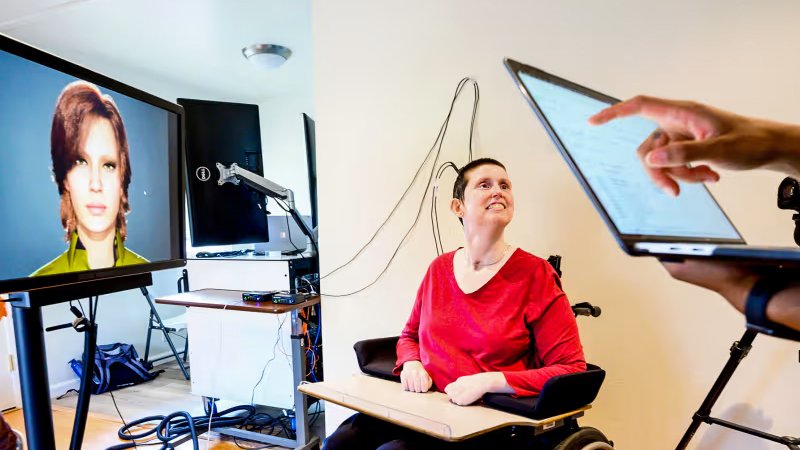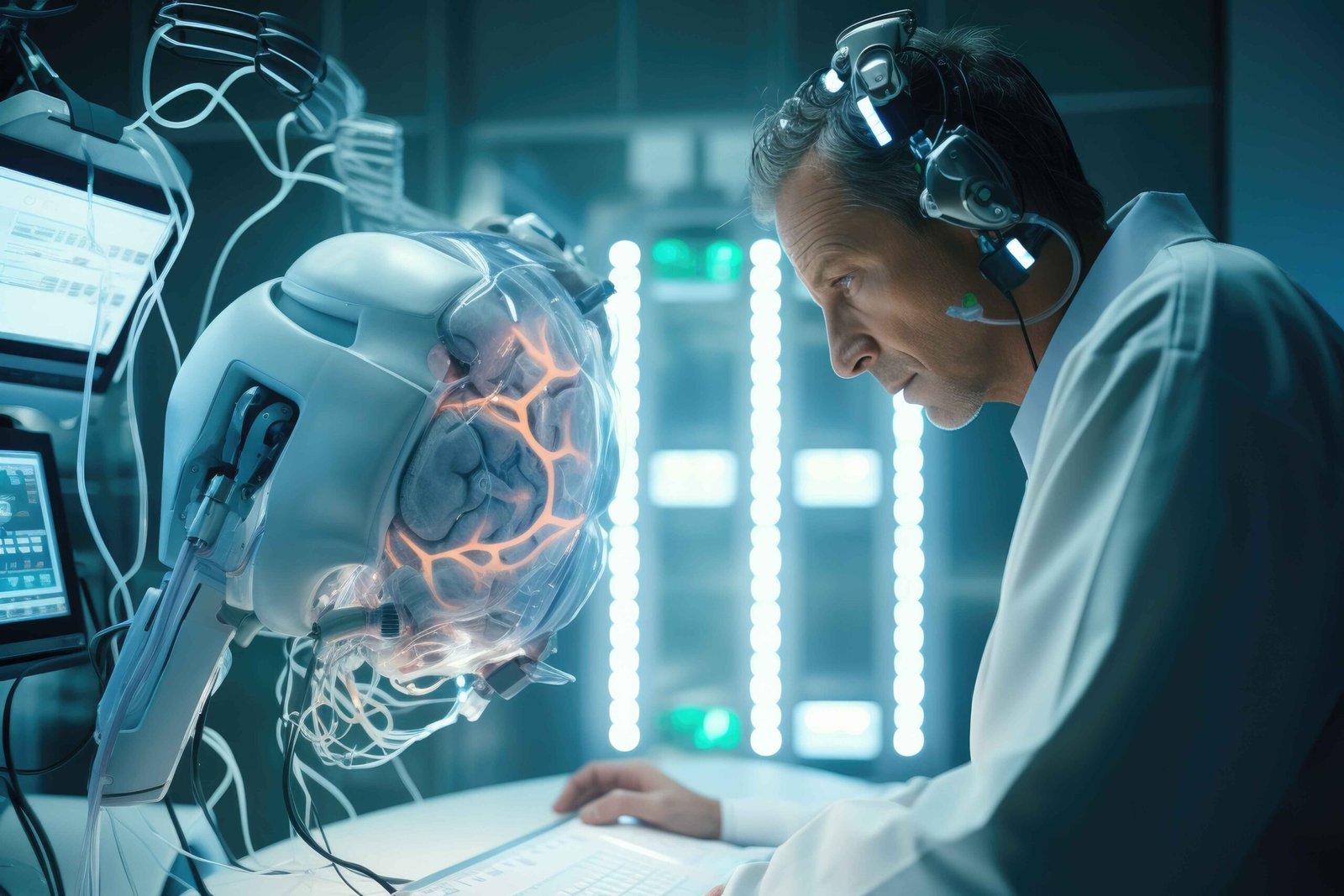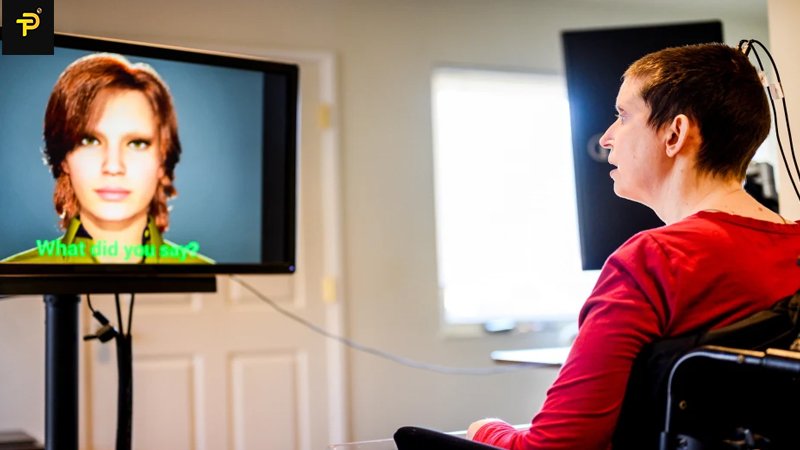AI Helps Paralyzed Woman Speak for the First Time in 18 Years
Introduction
Imagine not being able to speak for nearly two decades—unable to express your thoughts, emotions, or needs. This was the reality for one woman, paralyzed and silenced by her condition, until a groundbreaking moment brought her voice back. In a remarkable blend of technology and human perseverance, AI helps paralyzed woman to speak for the first time in 18 years. This story is not just a testament to the power of modern medicine, but a beacon of hope for countless others facing similar challenges.
The Background Story
Eighteen years ago, life took a drastic turn for a woman whose name is Ann Johnson.
In 2005, Ann Johnson, at the age of 30, experienced a stroke that resulted in severe paralysis, leaving her unable to speak. Although she could only make basic sounds like “ooh” and “ah,” her brain remained active, continuing to send signals.
Now, 18 years later, a groundbreaking experimental technology has achieved a significant scientific breakthrough by converting those brain signals into audible words. This innovation allows her to communicate once again through a digital avatar.
Technology Development
Researchers at the University of California, San Francisco, and the University of California, Berkeley, have developed a technology that uses an implant placed on the surface of Ann Johnson’s brain in areas responsible for speech and language.
This implant, which was surgically placed last year, is equipped with 253 electrodes that capture brain signals from thousands of neurons. During the procedure, doctors also installed a port in her head that connects to a cable, allowing these signals to be transmitted to a computer system.
The computers, using artificial intelligence algorithms, interpret these brain signals into sentences, which are then spoken by a digitally animated figure. For example, when Johnson attempted to say, “Great to see you again,” the avatar on a nearby screen spoke those words aloud.
This system is notably faster and more precise than earlier technologies that attempted to achieve similar results, enabling Johnson to communicate with a much broader vocabulary.

To make the avatar’s voice more personal, the researchers used a recording of Johnson speaking at her wedding. Additionally, the system translated her brain signals into facial expressions on the avatar, such as pursing lips or showing emotions like sadness or surprise.
The findings from this experiment were published on Wednesday in the journal Nature.
Dr. Edward Chang

Dr. Edward Chang, one of the study’s authors and the surgeon who performed Johnson’s operation, expressed his excitement about seeing her communicate through the avatar.
“It’s incredibly rewarding to witness this technology working in real time,” said Chang, who is the chair of neurological surgery at UCSF, during a news briefing.
The technology was able to translate Johnson’s speech attempts into words at a rate of nearly 80 words per minute. While the natural pace of speech is about 150 to 200 words per minute, the system achieved a median accuracy of around 75% when Johnson used a vocabulary of 1,024 words.
Ann Johnson’s Feedback

In a feedback survey, Johnson shared that she felt emotional when she heard the avatar speak in a voice that sounded like hers.
“For the first seven years after my stroke, all I had to communicate was a letterboard. My husband grew so tired of having to get up and interpret the letterboard for me,” she wrote.
The Role of AI in Medical Innovations

The last decade has seen rapid advancements in AI, particularly in healthcare. AI’s ability to analyze vast amounts of data and learn from it has opened new frontiers in diagnosing and treating diseases. Neurology, the study of the nervous system, has particularly benefited from these advancements. AI technologies, like machine learning algorithms and neural networks, are now being used to understand complex neurological conditions and even restore lost functions.
AI’s growing significance in assisting disabled individuals cannot be overstated. It is not just a tool for diagnosis but a partner in rehabilitation. For those like the paralyzed woman in our story, AI has become a bridge between their thoughts and the outside world, giving them a voice when they had none.
The Development of the AI System
The AI system that eventually helped this woman speak again was not an overnight success. It was the result of years of research, development, and testing. A multidisciplinary team of neuroscientists, engineers, and AI experts collaborated on this project, driven by the shared goal of breaking through the barriers of locked-in syndrome.
How the AI System Works
So, how does this groundbreaking AI system work? The technology relies on a combination of neural interfaces and advanced AI algorithms. A neural interface, often referred to as a brain-computer interface (BCI), is a device that connects the brain to an external computer system. In this case, it connects the paralyzed woman’s brain to a speech-generating device.
The AI interprets the brain signals received by the BCI. When the woman thinks about speaking, the neural interface detects the specific patterns of brain activity associated with speech. These patterns are then processed by the AI, which converts them into text or spoken words. It’s like having a direct line from the brain to the mouth, bypassing the usual physical channels that are no longer functional.
The Broader Impact on Society
This breakthrough has implications far beyond this one individual. It represents a significant step forward for AI in healthcare, particularly for those with severe disabilities. For individuals with conditions like ALS, spinal cord injuries, or other forms of paralysis, this technology offers hope that they too might one day regain lost abilities.
However, as with any technological advancement, there are ethical considerations to keep in mind. The use of AI in such intimate areas as thought and speech raises questions about privacy, consent, and the potential for misuse. Society must tread carefully as it integrates AI into more aspects of human life.
Future of AI in Medicine
The success of this AI system opens the door to numerous future applications. Researchers are already exploring how similar technologies could be used to assist with other lost functions, such as mobility or vision. The long-term benefits of AI in medicine are vast, potentially leading to cures and treatments for diseases that have long been considered incurable.
As AI technology continues to evolve, we may see it integrated into standard medical practice, where it could help diagnose conditions earlier, tailor treatments to individual patients, and even predict health issues before they arise.
Challenges and Criticisms
Of course, the rise of AI in healthcare is not without its challenges and criticisms. Ethical concerns are at the forefront, particularly regarding the privacy of neural data and the potential for AI to be used in ways that could harm rather than help. Moreover, the high cost of developing and implementing these technologies means that they may not be accessible to everyone who needs them.
There is also the question of reliance on AI. While it can offer incredible benefits, we must ensure that it complements rather than replaces human judgment and empathy in healthcare.
Conclusion
The story of how AI helps paralyzed woman to speak for the first time in 18 years is a milestone in medical history. It’s a powerful example of how technology can restore not just functions but also dignity and hope. As AI continues to advance, its potential to change lives grows exponentially. But as we embrace these new possibilities, we must also navigate the ethical and practical challenges they present.

2 responses to “AI Helps Paralyzed Woman To Speak for the First Time In 18 Years”
Thanks for sharing. I read many of your blog posts, cool, your blog is very good. https://accounts.binance.com/zh-TC/register-person?ref=VDVEQ78S
Thanks for sharing. I read many of your blog posts, cool, your blog is very good.